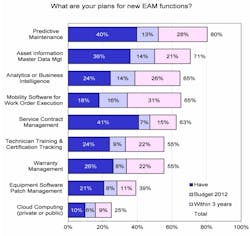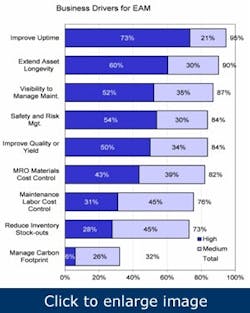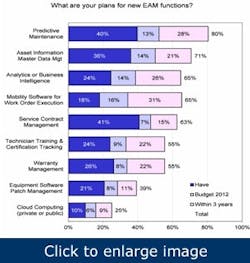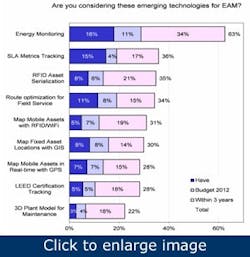In brief:
- The most desirable EAM functionality elements are predictive maintenance, analytics, and mobility.
- Users need EAM systems to support energy efficiency initiatives more strongly.
- Maintenance managers prefer a more functional report writer that can be displayed on a variety of media.
Asset management is the cornerstone of any manufacturer’s maintenance and reliability strategy. While stand-alone computerized maintenance management system (CMMS) software has evolved into enterprise asset management (EAM) systems that are designed to meet the expanded needs of the organization, industrial plants might be anywhere along the implementation curve — from those still employing paper-based work orders to those with fully integrated applications and mobile systems.
[pullquote]
Plant Services partnered with ARC Advisory Group (www.arcweb.com) to conduct a joint survey on asset management software and plot some of those points along the curve. The survey covered users’ current status and future plans for improvement. Most of the 184 participants are involved with multiple plants, and their responses represented input from a total of more than 7,500 facilities worldwide. This provides a substantial body of knowledge for comparison of operations and future changes. The survey provides insights on maintenance management and asset-management-software applications, and this article will refer to EAM as an all-inclusive term.
Drivers for an EAM system
Asset management software provides the means for a maintenance department to achieve its objectives for equipment uptime, asset longevity, and safety, while controlling costs. Improved uptime is the clear top reason given for having an EAM system. Production needs equipment to be operating properly to make product, customer shipments, and sales revenue. Asset longevity delays the need to replace expensive assets and conserves cash — a key interest of top executives. In asset-intensive industries, maintenance and the EAM system provide the means to ensure both revenue and a sound balance sheet.
Figure 1. The survey offered respondents four choices for each of the business drivers: high, medium, low, and “not a factor.” The high and medium responses are included.
Visibility also ranked high as a reason for an EAM system, which provides maintenance personnel — planners, schedulers, technicians, and management — with the information needed to make better decisions more quickly and to achieve their objectives.
Additional functions
Predictive maintenance, mobility, and analytics ranked high as they’re the most planned acquisitions within the next three years.
Predictive maintenance: This continues to have the top ranking. The large response for acquisition within three years indicates that many are having difficulty with implementation cost and the financial benefits. Predictive maintenance requires condition monitoring. Many might be wrestling with purchasing a system for vibration or other variables. However, the answers to a separate question for condition monitoring show that most connect to the historian. This involves configuration and integration with the email or EAM systems. Using the historian avoids investments in new condition monitoring applications, hardware, infrastructure, and people. Leveraging the existing investment in the historian enables broader use of predictive maintenance. The financial benefits come from reduced downtime, preventive maintenance, and production losses.
Mobility: This has become an active area for technicians processing work orders while they’re in the field. The ugly reality is that paper and manual systems remain the most common means for processing maintenance work orders. With paper, data entry occurs well after the work is done — usually at the end of a shift, when the technician has other things to do before going home. Lack of compliance and corresponding data integrity cause people to lose confidence in the EAM system and revert to other methods.
Mobility extends the business processes for asset management to the point of action at the asset. When data entry becomes part of the workflow, many opportunities for process improvement become available. Adoption of smart phones has improved awareness and the acceptability of these solutions. Also, using less-expensive consumer devices lowers the hardware investment significantly. The rising awareness and lower implementation costs drive high interest in mobility implementations.
Analytics: Both analytics and asset information master data management have high plans for adoption. Clearly, managers want better tools for managing a business in an increasingly dynamic environment.
Unfortunately, the specific meaning of analytics has a wide variety of interpretations. Some take the view of an easy-to-use report writer that extracts data from the EAM system and generates reports with charts or dashboards for upper management, usually showing key operating metrics. On the other end of the spectrum, analytics involves business intelligence with the integration of data from a variety of systems for ad hoc analysis and investigation.
{pb}
Figure 2. When the return on investment (ROI) is well-understood and falls “above the line” for justification, new EAM functions usually go into the current budget. If the company likes the new capability but has difficulty with the financial benefits, it falls into a wish list for the future. Choosing “acquisition within three years” indicates difficulty quantifying the financial justification.
Discussions with maintenance managers indicate they prefer a more functional report writer that can be displayed on a variety of media — paper, PC screen, tablet, and smart phone. Many of these reports cover a given time frame, such as a shift, a week, or a month. The growing interest includes a more real-time nature with reports containing operating information that is current to within 15 minutes.
Existing and planned functions
Energy Management: The recent green and sustainability initiatives have coalesced around the area that provides clearly identifiable and auditable savings, primarily electric power and other energy sources. While energy monitoring has been an accepted application for decades, using EAM to collect, aggregate, and report this information is a new trend. The EAM system provides a platform for integrating specific power management solutions with plant-wide visibility for energy consumption by device, particularly when energy use can be measured for individual assets.
EAM systems include asset information management (AIM) functionality and associated data for the individual assets. Because energy use can be measured for individual assets, the EAM system becomes a platform for enterprise-wide energy management. For example, users could identify the electric motors with a particular characteristic, such as 100 hp, and compare motor efficiency values across the company. Adding the price of electric power provides an easy way to calculate the cost of an inefficient motor and the payback for a replacement. Essentially, energy management leverages the core AIM functionality of EAM.
Figure 3. Energy management and SLA metrics tracking head the list of new technologies being consider
Key metrics: Uptime continues to be the key metric for maintenance. Asset longevity, cost control, safety, and quality follow close behind. EAM systems provide the visibility and decision support needed for succeeding with these objectives.
Predictive maintenance: Predictive maintenance applies maintenance when it’s really needed. Replacing preventive with predictive reduces maintenance costs and improves uptime. An historian provides a low-cost vehicle for implementing predictive maintenance.
Mobility: The cost, benefits, and user acceptance of mobility changed dramatically in just a few years. Organizations that considered mobility for technicians to process work orders in the past and declined should take another look. For those using paper, mobility probably provides a better option.




